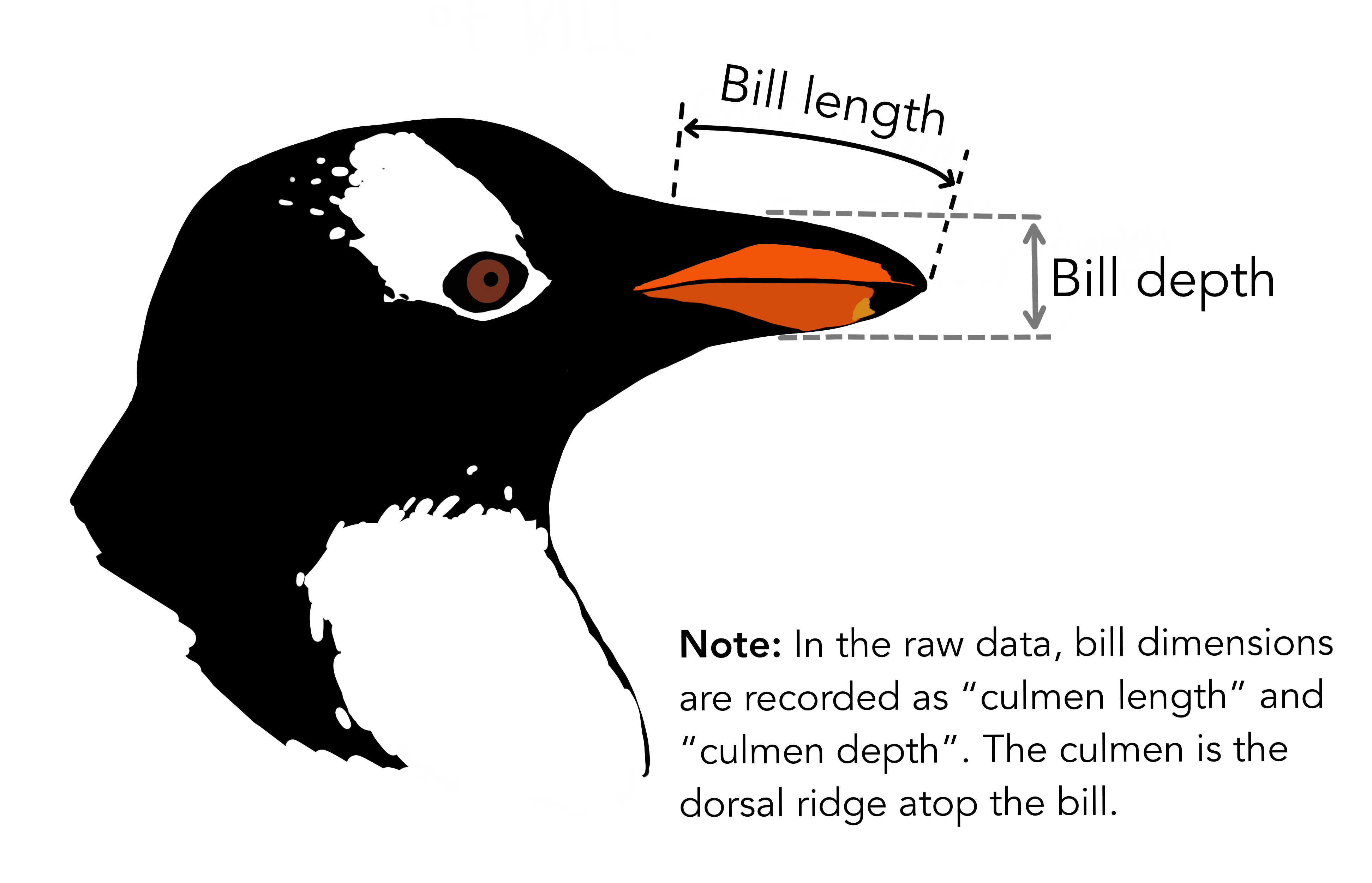Working with files and directories#
We now know how to explore files and directories, but how do we work with them? Moving, copying, creating, etc.
Let’s change into the shell-lesson-data directory that you downloaded earlier, where there’s some example data we’ll work with:
$ cd ~/Downloads/shell-lesson-data/
Downloading the example data
If you didn’t already download the example data, click here, then unzip the resulting zip file, leaving it in your Downloads folder.
Let’s see what it contains:
$ ls
alkanes creatures numbers.txt penguins.csv writing
There are a few files and directories. For now we’re going to work with the penguins.csv file.
Viewing a file#
How can we see what’s in penguins.csv?
The simplest way is a command called cat. cat takes the name of a file as
it’s argument, and prints the contents of that file:
$ cat penguins.csv
This should print something like:
Chinstrap,Dream,42.5,16.7,187,3350,female,2008
Chinstrap,Dream,51,18.8,203,4100,male,2008
Chinstrap,Dream,49.7,18.6,195,3600,male,2008
Chinstrap,Dream,47.5,16.8,199,3900,female,2008
Chinstrap,Dream,47.6,18.3,195,3850,female,2008
Chinstrap,Dream,52,20.7,210,4800,male,2008
Chinstrap,Dream,46.9,16.6,192,2700,female,2008
Chinstrap,Dream,53.5,19.9,205,4500,male,2008
Chinstrap,Dream,49,19.5,210,3950,male,2008
Chinstrap,Dream,46.2,17.5,187,3650,female,2008
Chinstrap,Dream,50.9,19.1,196,3550,male,2008
Chinstrap,Dream,45.5,17,196,3500,female,2008
Chinstrap,Dream,50.9,17.9,196,3675,female,2009
Chinstrap,Dream,50.8,18.5,201,4450,male,2009
Chinstrap,Dream,50.1,17.9,190,3400,female,2009
Chinstrap,Dream,49,19.6,212,4300,male,2009
Chinstrap,Dream,51.5,18.7,187,3250,male,2009
Chinstrap,Dream,49.8,17.3,198,3675,female,2009
Chinstrap,Dream,48.1,16.4,199,3325,female,2009
Chinstrap,Dream,51.4,19,201,3950,male,2009
Chinstrap,Dream,45.7,17.3,193,3600,female,2009
Chinstrap,Dream,50.7,19.7,203,4050,male,2009
Chinstrap,Dream,42.5,17.3,187,3350,female,2009
Chinstrap,Dream,52.2,18.8,197,3450,male,2009
Chinstrap,Dream,45.2,16.6,191,3250,female,2009
Chinstrap,Dream,49.3,19.9,203,4050,male,2009
Chinstrap,Dream,50.2,18.8,202,3800,male,2009
Chinstrap,Dream,45.6,19.4,194,3525,female,2009
Chinstrap,Dream,51.9,19.5,206,3950,male,2009
Chinstrap,Dream,46.8,16.5,189,3650,female,2009
Chinstrap,Dream,45.7,17,195,3650,female,2009
Chinstrap,Dream,55.8,19.8,207,4000,male,2009
Chinstrap,Dream,43.5,18.1,202,3400,female,2009
Chinstrap,Dream,49.6,18.2,193,3775,male,2009
Chinstrap,Dream,50.8,19,210,4100,male,2009
Chinstrap,Dream,50.2,18.7,198,3775,female,2009
$
You can see this file is pretty big! There’s so many lines that they don’t all fit on the screen at once.
We can see just the first few lines using the head command. head accepts a -n option to specify the number of lines to show (if you don’t pass -n, it defaults to 10 lines). Let’s look at the first 5 lines:
$ head -n 5 penguins.csv
species,island,bill_length_mm,bill_depth_mm,flipper_length_mm,body_mass_g,sex,year
Adelie,Torgersen,39.1,18.7,181,3750,male,2007
Adelie,Torgersen,39.5,17.4,186,3800,female,2007
Adelie,Torgersen,40.3,18,195,3250,female,2007
Adelie,Torgersen,36.7,19.3,193,3450,female,2007
The dataset we’re looking at is called the “Palmer Penguins” dataset. It contains data on penguins penguins sampled from three islands in the Palmer Archipelago, Antarctica between 2007 and 2009.
This format is called “comma-separated values”, or CSV for short (hence
the .csv extension). Each column is a different variable, and each row is a
different penguin. CSV is a common format for tabular data, and can be exported
and imported by many programs, especially spreadsheet software like Excel.
The most convenient way to view long files like this is to use what’s called a
“pager”, which lets you scroll through the file one “page” at a time. The most
common pager is less, so named because it let’s you see less of the file at once.
$ less penguins.csv
Now you’re in the pager view. Use ↑ and ↓ to move
line-by-line, or try b and Spacebar to skip up and down by a full page. To
quit and return to the shell prompt, press q.
Copying files#
We’re going to do some analysis on the penguins data. Let’s make a copy of it, in case we mess something up and want to go back to the original later.
To do this, we use the cp command. cp takes two arguments: the source file that we want to copy, and the destination filename where we want the copy to end up.
cp penguins.csv penguins2.csv
cp gives no output when it succeeds, but we can use ls to confirm that a copy of the file has been created:
$ ls
alkanes analysis creatures numbers.txt penguins.csv penguins2.csv writing
Creating directories#
Let’s also make a new directory to store our analysis results.
$ mkdir analysis
mkdir means “make directory”.
$ ls
alkanes analysis creatures numbers.txt penguins.csv writing
Since we just created it, it has nothing in it, which we can confirm using ls. So far, we’ve only used ls with no arguments, but ls can take an argument: the name of a different directory to list. By default, it lists the current working directory, but we can give it any other directory instead. Let’s list the contents of the analysis directory:
$ ls analysis
$
We can see that there’s nothing there.
Challenge: mkdir and good names for directories
What do you think will happen if you run this command?
mkdir my directory
Think about it, decide what you think the result will be, then run the command.
What happened? Why do you think this is the case?
Solution
This command creates two separate directories: my and directory:
$ mkdir my directory
$ ls
alkanes analysis creatures directory my numbers.txt penguins.csv writing
You might have expected it to create a single directory called “my directory”. It creates two because in the shell, spaces are used to separate multiple arguments. mkdir can create multiple directories at once if you pass it multiple arguments.
This teaches us a valuable lesson. When working with the shell, it’s best to avoid spaces in names of directories and files. Because of the special meaning of space as the argument separator, file and directory names with spaces can be difficult and confusing in the shell. Use characters like - or _ instead.
Moving and renaming files#
Now let’s move the copy of the penguins data to our new analysis directory. To do this, we use the mv command (short for “move”). mv is very similar to cp, but it moves the file instead of copying it.
Just like cp mv takes two arguments: the source file and the destination. When the destination is a directory, mv will move the file into that directory.
$ mv penguins2.csv analysis/
Let’s confirm that the file has been moved. First, we’ll list the contents of the current directory:
$ ls
alkanes analysis creatures numbers.txt penguins.csv writing
We see that penguins2.csv is no longer there.
Now, let’s change into our analysis directory and list its contents:
$ cd analysis
$ ls
penguins2.csv
We see that penguins2.csv is now in the analysis directory, and is the only file here.
The name penguins2.csv is a bit silly now that we’re in a different directory, so there’s no name conflicts. Let’s change the name of the file to just data.csv. We also use the mv command for this. If you think of the full path to a file as it’s location, re-naming is just moving it to a different path, so it uses the same command:
$ mv penguins2.csv data.csv
$ ls
data.csv
Removing#
Let’s go back to the shell-lesson-data directory and clean up a bit:
$ cd ..
We’re only going to work with the penguin data today, so we don’t need the other files. We can delete them using the rm (short for “remove”) command.
For example, to delete the numbers.txt file, we can use:
$ rm numbers.txt
We can confirm the file is gone using ls:
$ ls
alkanes analysis creatures penguins.csv writing
If we try to remove the alkanes directory using rm alkanes, we get an error message:
$ rm alkanes
rm: cannot remove 'alkanes': Is a directory
This happens because rm by default only works on files, not directories.
rm can remove a directory and all its contents if we use the recursive
option -r, and it will do so without any confirmation prompts:
$ rm -r alkanes
rm -r should be use with great caution, because it can permanently delete a
lot of files without asking for confirmation if you make a mistake.
Deleting is forever
Files deleted with rm cannot be recovered from a “trash bin” like files deleted using a GUI. Be very careful when deleting files using rm.
We can use ls again to confirm that the directory is gone:
$ ls
analysis creatures penguins.csv writing


